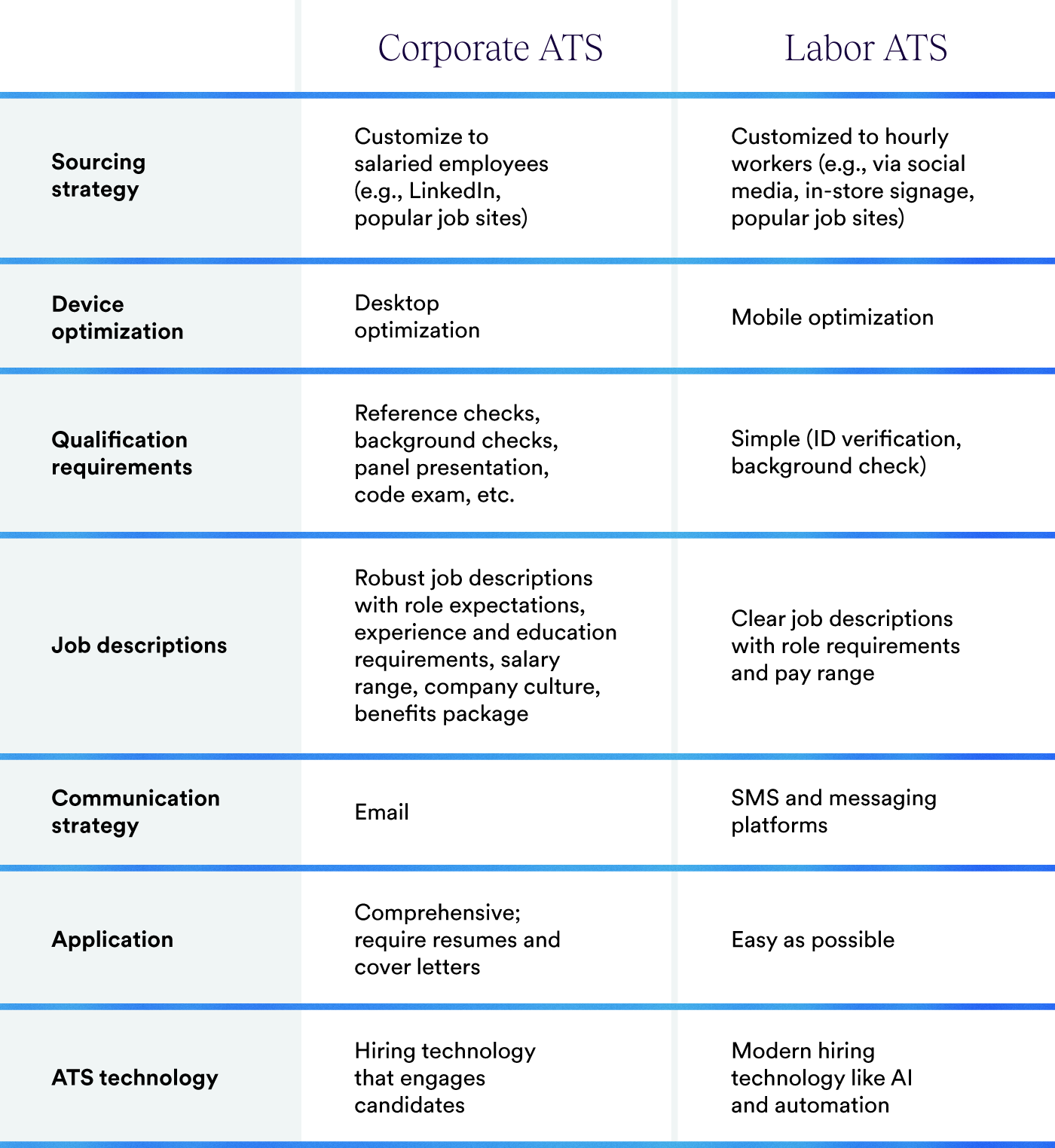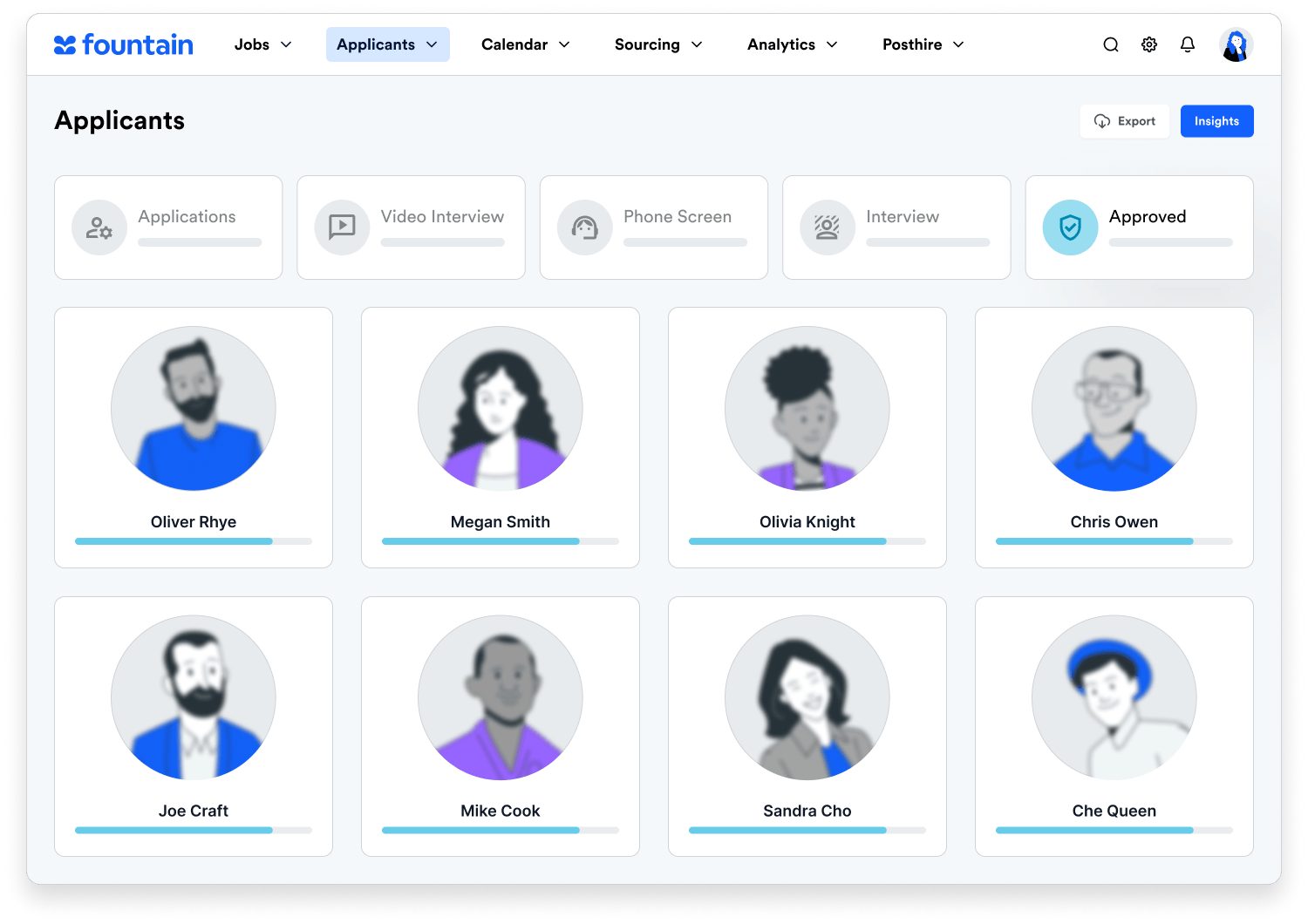Hiring hourly workers differently from corporate workers will yield better business results.
Hiring hourly workers can be a challenging task for many organizations, especially those in industries like retail, hospitality, and healthcare. The demand for hourly roles is usually high, with turnover rates that are just as high. Finding the right candidates and making the hiring process as efficient and streamlined as possible is crucial to ensure your business can operate smoothly and meet the needs of your customers.
The never-ending cycle: Why hiring hourly workers can be challenging
With hourly workers making up the majority of the workforce, most employers struggle with not only getting workers to day one, but also retaining them for long enough to make the process worthwhile. According to a study from the U.S. Bureau of Labor Statistics, the average turnover rate is 47%. Combined with the fluctuating economy and seasonal demand, organizations are constantly hiring and training new workers to keep operations staffed.
While hiring hourly workers has some hurdles, technology can help address the unique needs and requirements of hourly workers and streamline the hiring process, enabling organizations to build a productive and successful hourly workforce.
One size doesn’t fit all: Why a Corporate ATS is different from a Labor ATS
A common practice across employers is to use one applicant tracking system (ATS) to solve all hiring challenges, when in reality, they are fundamentally different processes. A Corporate ATS is designed to handle the hiring process for traditional corporate roles, while a Labor ATS is specifically designed to handle the unique needs and challenges of hiring hourly workers. We’ve broken down some of the key differences between each:
Corporate ATS: Optimized for hiring talent into salaried positions
- Customize your sourcing strategy to hire salaried employees (e.g., LinkedIn, popular job sites)
- Use hiring technology that engages candidates
- Ensure desktop optimization for applications
- Make applications comprehensive; require resumes and cover letters
- Leverage email to communicate with candidates
- Write robust job descriptions with role expectations, experience, education requirements, salary range, company culture, and benefits package
- Elaborate on qualification steps to ensure you’re hiring the best candidate (e.g., reference checks, background checks, panel presentation, code exam, etc.)
Labor ATS: Optimized for hiring hourly, blue-collar workers into evergreen positions
- Customize your sourcing strategy to hire hourly employees (e.g., via social media, in-store signage, popular job sites)
- Use modern hiring technology like AI and automation
- Ensure mobile optimization
- Make applications as easy as possible
- Leverage SMS to communicate with hourly candidates
- Write clear job descriptions with role requirements and pay range
- Simple qualification steps (ID verification, background check)

Having a Labor ATS allows you to streamline the hiring process for hourly workers and reduce the time and effort it takes to fill these roles. This can be especially important during times of high demand when you need to quickly fill open positions. Additionally, a Labor ATS can help you improve the candidate experience, making it easier for them to apply and increasing the likelihood that they will accept a job offer.
Top 5 ways to optimize your hourly recruiting strategies
There are a variety of ways to optimize your process for hiring hourly labor but we’ve broken down the top fivemethods to help you improve your existing recruitment strategy.
Prioritize simplicity: Make it easy for hourly applicants to apply
Organizations need to make the application process easy for hourly roles in order to attract the best candidates and reduce turnover rates. According to a recent study from Robert Half, 57% of job seekers lose interest in a job if the hiring process is lengthy. Hourly workers are often looking for work immediately or are too busy with other commitments and obligations to spend time on a job application, so it’s important for the hiring process to be quick and simple.
An easy application process also makes it more likely that candidates will follow through and start work as soon as possible, improving the overall efficiency of the hiring process. Streamlining the application and making it more user-friendly allows organizations to be sure they are attracting the right candidates and creating a positive experience for those who apply, leading to a more productive and successful workforce.
Establish mobile-first processes: Engage candidates with SMS, WhatsApp and messaging apps
A mobile-first approach can make it easier for hourly candidates to apply from their phones, which is the device they use most frequently. By designing a mobile-friendly application process, organizations can make it easier for candidates to apply on-the-go and from any location. This approach also allows organizations to reach a wider pool of candidates, as many hourly workers may not have access to a computer or may prefer to use their phone for job searching.
A mobile-first approach can also improve the candidate experience, making it more convenient and user-friendly. By making it easy for candidates to apply from their phones, organizations can improve the efficiency and success of their hourly worker hiring process.
Get straight to the point: Meet candidates where they are
Meeting hourly candidates where they are is an important aspect of attracting and retaining the best candidates. By allowing candidates to apply on their phones and providing them with the option of on-demand, instant, or scheduled interviews, organizations can accommodate the unique needs and schedules of hourly workers. This approach can also make the hiring process more convenient and user-friendly, improving the candidate experience and increasing the likelihood that candidates will follow through with the process. Provide flexible interview options to better assess the skills and abilities of candidates in real time and make it easier to determine if they are the right fit for the role.
Rethink requirements: Is every qualification step necessary?
When thinking specifically about hourly positions, recruiters and hiring managers have the opportunity to rethink qualification steps to ensure that the hiring process is efficient and effective. Things like assessments, background checks, and references may not necessarily be required for every position. Evaluating the qualifications required for each role and making sure they are relevant to the job can help to streamline the hiring process and reduce the amount of time and resources required to fill each position.
By focusing on the essential qualifications and skills, recruiters and hiring managers can better assess the suitability of candidates for the role, improving the accuracy of their hiring decisions. This approach can also help to reduce the number of unqualified candidates who apply for the role, saving time and resources for both the organization and the candidate.
Assessments should be timed correctly and accurately reflect the demands of the role to ensure they are helping recruiters find the best candidate for the position. For example, timing assessments for later in the process allows recruiters to evaluate if they are capable of performing the duties of the role. Accurate assessments also provide valuable insights into a candidate’s strengths and weaknesses, making it easier to determine if they are a good fit for the role and the organization.
At a higher level, organizations may reassess if a background check is necessary for each hourly role and whether it’s necessary to protect the organization and its employees. Background checks can provide valuable information about a candidate’s criminal history, work history, and education, allowing recruiters to make more informed hiring decisions. However, background checks can also be time-consuming and expensive, may insert bias into the process, and may not be necessary for all hourly roles. Most importantly, recruiters should make informed decisions about when to conduct background checks to ensure the safety and security of their organization while also optimizing the efficiency of their hiring process.
Automate interviews: Leverage technology to streamline manual steps
If an interview is necessary to hire an hourly worker, consider automating the interview scheduling process to save time and resources. There are different types of interviews, including in-person, recorded, and virtual interviews, and each has its own advantages and disadvantages. Automating the scheduling process can help streamline the hiring process and make it more convenient for both the recruiter and the candidate. By leveraging an automated scheduling system or conversational AI, recruiters can quickly and easily schedule interviews with candidates, reducing the time and resources required to coordinate in-person or virtual interviews. Automating the interview process ensures that each candidate has a positive and efficient experience, which can increase the likelihood that they will show up for their interview and start work on time. By determining the necessity of interviews and automating the scheduling process, recruiters can make the hiring process more efficient and effective.
Hourly hiring software: Blue-collar workers should be hired differently
Treating hourly workers differently from corporate workers can yield better business results. A Labor ATS specifically designed for hiring hourly workers allows organizations to streamline the process and make it easier for candidates to apply. By making the process more efficient and candidate-friendly, organizations can reduce turnover rates and improve the candidate experience, leading to a more productive and successful workforce. Additionally, by recognizing the unique needs and challenges of hourly workers, organizations can improve their bottom line and better meet the needs of their customers.
If you’re interested in learning more, Fountain is optimized for the high volume hiring of hourly workers, enabling an applicant experience backed by an automated workflow that is specific to role and location. See Fountain in action by requesting a demo.

